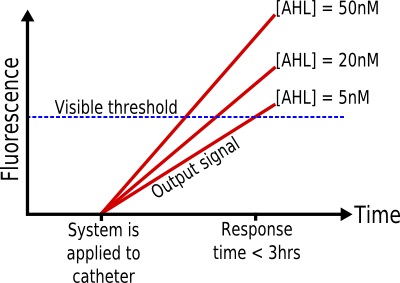Imperial/Infector Detector/Specification
From 2007.igem.org
(Difference between revisions)
(→Specifications in detail) |
(→Specifications in detail) |
||
| Line 39: | Line 39: | ||
== Specifications in detail == | == Specifications in detail == | ||
| + | [[Image:IC07 spec sysresponse.png|thumb|300px|right|Desired response of Infector Detector. Note that the response is not necessarily linear, as indicated.]] | ||
* '''Input: AHL 5-50nM''' | * '''Input: AHL 5-50nM''' | ||
* '''Output: Fluorescent Protein''' | * '''Output: Fluorescent Protein''' | ||
| - | |||
| - | |||
| - | |||
| - | |||
* '''Response Time''' | * '''Response Time''' | ||
* '''Operating Conditions''' | * '''Operating Conditions''' | ||
Revision as of 21:54, 22 October 2007

Infector Detector: Specifications
The system must be able to detect the presence of biofilms on urinary catheters by detection of AHL, at a minimum concentration of 5nM, and report with a visual signal within 3 hours. It must work within a temperature range of 20°-30°C, be portable and easy to use, have a shelf life of at least seven days, and must not be harmful or infectious.
| Inputs | |
| Outputs | |
| Response Time | |
| Operating Conditions | |
| Health & Safety | |
| Lifespan | |
| Packaging |
Specifications in detail
- Input: AHL 5-50nM
- Output: Fluorescent Protein
- Response Time
- Operating Conditions
- Health & Safety
- Packaging and Shelf-life
